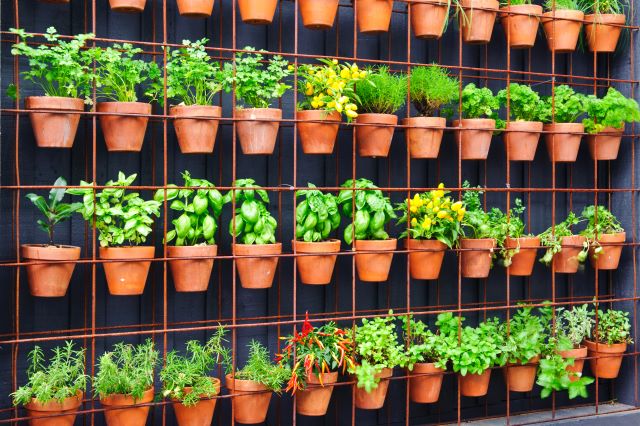The Ultimate Guide to Herb Gardening
Herbs add not only flavor to your food, they also have a great number of health benefits. If you’re new to herb gardening or want to take your gardening skills to the next level, this ultimate guide is for you. We will discuss all aspects of growing herbs – from its benefits to planning, planting and care. We will also cover various types of herbs, how much sunlight they need, should be started by seed, and the best way to harvest. We will also talk about saving and storing herbs, the top medicinal herbs to grow at home, pollinators, companion planting and answer some questions. Fortunately, herbs are one of the easiest plants to grow, so let’s get started.
Benefits of Growing Herbs
Many people will attest that cultivating a herb garden can be a fulfilling pastime at the same time providing fresh and nutritious herbs for cooking. It is a sustainable way to obtain high-quality herbs whilst reducing your carbon footprint. It doesnt matter if you have an indoors or outdoor garden or in a raised bed or planter. Just make sure there is good drainage and adequate sunlight. You will enjoy the fragrance of basil, thyme, rosemary and dill, and the added flavors in your cooking.
Why you should grow your own common herbs

Which fresh herbs are easy to grow?
Which Herbs Regrow Best After Cutting?
The Best Herbs to Plant in your Herb Garden
Best Herbs for Your Sunny Window sill
Which herbs are low maintenance?
How to plan your herb garden
When you plan your herb garden, first decide on the best location. If you have small spaces, consider raised beds or containers. Make sure you have good drainage and an adequate amount of daily sunlight. Compost or fertilize your garden regularly by adding quality organic matter and slow release fertilizer.
Herbs can easily be integrated into a vegetable garden but dont forget about the sunlight and soil requirements. For proper drainage in your garden bed or planter try adding an inch of gravel before filling with soil.
Good planning based on the herb type, water, sunlight and soil needs can result in a successful herb garden that adds fresh flavors and aromas to your cooking.
What are perennial herbs?
Caring for Your Herb Garden
To keep your herb garden thriving, make sure that every plant receives sufficient sunlight and moisture. Regular pruning promotes healthy foliage growth while avoiding overcrowding and shading. Good drainage holes in high-quality soil will help prevent root rot. For natural pest control methods, companion planting with pollinators like bee balm or calendula can attract beneficial insects and at the same time repel pests.
What is best season for growing season for herbs?
For successful herb growth, they need at least 6 hours of direct sunlight daily. Some herbs like mint and parsley can tolerate partial shade. A lack of sunlight may result in leggy or stunted growth. To get the best from indoor herbs, place them near a sun-facing window to maximise the sunlight exposure.
Common Herb Pests and Diseases
The best herbs to plant together
Companion Plants for Herb Gardens
Companion planting is the technique of growing certain plants jointly for their mutual benefit. This strategy is also useful in herb gardening as it helps to deter pests and enhance soil quality. Good companion plants for herbs include marigolds which repel aphids; chives that keep away snails and slugs; and dill attracts ladybugs and lacewings which hunt garden pests.
Which Herbs Should Be Grown from Seed?
The Importance of Correctly Harvesting
Harvesting herbs properly is really important so as to achieve the best flavor and quality. Optimal growth and flavor can be achieved by harvesting at the right time in the season. To avoid damaging the plant or introducing bacteria whilst harvesting rosemary, oregano, or mint make sure you use clean, sharp tools
How to harvest, store and dry herbs you have grown in your garden
Choosing the right time to harvest is important to ensure optimal flavour & potency. Make sure you use clean tools when and choose the appropriate way of storing your herbs. Perhaps consider alternative ways like herbal-infused oils/vinegars. Most herbs can be bundled and hung up to dry. All you need to do is expose the leaves, flowers or seeds to warm, dry air in a dark and well ventilated area.
Top 10 Medicinal Herbs to Grow at Home
How to make herbal tea
Infusing Oils with Herbs
Create your own herb-infused vinegar
Homemade Natural Remedies with Herbs
Often homemade natural remedies are a great way to use fresh herbs. Chamomile, lavender, and peppermint are perfect for making teas or infused oils for various conditions. Garlic and ginger are known for their immune-boosting properties and can easily be added to meals or taken as supplements. Echinacea is great for fighting colds and flu while St. John’s Wort can treat depression. If you grow your own medicinal herbs it will save you money and give you comfort that you know exactly what is going into your remedies.
Pollinators and Your Herb Garden
Frequently Asked Questions about Herb Gardening
What questions do most new herb gardeners have?
How many hours of sunlight are required to grow herbs?
Conclusion
Growing herbs can be a fun and rewarding. At the same time it can improve your health, benefit your wallet, and the environment. Start small!. If you use this guide to growing herbs, you can learn the best ones to plant in your garden, how to care for them and even which ones have medicinal properties. Why not start planning your herb garden today and enjoy the benefits of fresh, delicious herbs right at your fingertips and on your dinner plate.
